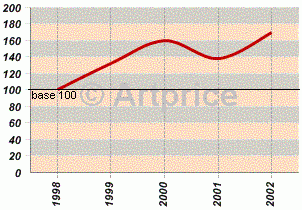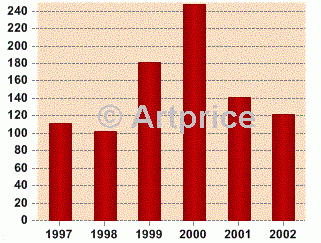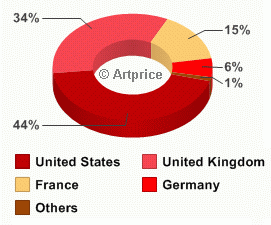Ando Hiroshige (1797 – 1858)
[10 Apr 2003]
Like his immediate predecessor Katsushika Hokusai, Utagawa Hiroshige is one of Japan’s leading landscapists. Single prints are affordable. Full series set records.
When Ando Tokutaro – who painted under the name Hiroshige ANDO – began his career the fashion was for figures of actors and portraits of women. He learnt landscape painting under his master, Utagawa Toyohiro, and went on to practise the genre at its highest level following in the footsteps of his famous precursor, Katsushika HOKUSAI (1760-1849), whose Thirty-six views of Mount Fuji were then enjoying tremendous success. Hiroshige’s best-known work is unquestionably the Tokaido Gojusan Tsugi-no Uchi (53 stages of the Tokaido) series — 53 prints of the Tokaido road between Edo and Kyoto. The series was first published in 1833-1834 but, cashing in on its success, the artist put out a further 15 editions by 1855. Hiroshige was first recognised in the west. Van Gogh was a fan and produced imitations of several works. At the time, the ukiyo-e genre had fallen out of fashion in Japan and was only preserved partly thanks to a string of French collectors including Monet and Lautrec, who began collecting early in the twentieth century. The auction market took off again with the break-up of some prestigious collections including Henri Vever’s in 1974 and Huguette Berès’s in November 2002. At this most recent sale in Paris, 30 lots of Hiroshige prints went under the hammer.
Artworks at auctions
Utagawa Hiroshige made five thousand prints over the course of his career. In 2002, no less than 121 lots came up for auction. Two thirds were single prints and of these 64% went for less than EUR 1,000. But collectors will pay much more for whole series, the 100 views of Edo and 53 stages of the Tokaido being the most sought-after. A crucial issue is the edition from which they are drawn. Hiroshige’s successful prints were often reissued many times and quality varies dramatically from one edition to another. A complete album can fetch more than EUR 100,000. The highest price ever paid for a work by the artist was EUR 748,000 for 120 prints drawn from the 100 views of Edo, on 20 June 2002.
The market places
For around 30 years Japanese prints have been flowing back into Japan, often to newly-opened private museums. But the prestige end of the market remains in the USA, which handles 24% of lots sold, but makes 44% of turnover. With a 34% market share the UK also hosts the sale of many prestigious lots. Most individual prints are sold in France and Germany. Together these two markets handled 54% of all Hiroshige lots to go under the hammer between 1999 and 2002.
Buy or sell
Prices are now nearly twice what they were in 1997. As with many other masters of Japanese prints, there was a surge in interest in 1998-2000 due to the break-up of a number of major collections. Auctions multiplied and the price level for Japanese prints rose 60% in this period. Over the same period the number of works coming up for auction tripled. Many artists set records at this time and Utagawa Hiroshige joined them when a collector paid USD140,000 for a series of the 100 views of Edo at Christie’s 19 September 2000 sale in New York. A few days later at Sotheby’s London this was matched by the GBP 97,000 paid for another complete album of the 100 views of Edo (USD139,000). With a mass of prints coming to market demand has become highly selective. Less than 5% of lots offered in 1998 were bought in. By 2000 this had risen to 16%. Meanwhile, these big ticket sales have kept the market for Utagawa Hiroshige bubbling and plentifully supplied. Whenever a good piece comes up, expert collectors are eager to bid. A series of the 53 stages of the Tokaido sold recently, on 18 September 2002, for USD180,000.
Ando Hiroshige Artprice Indexprints, base January 1998 = 100, currency: EUR  Ando Hiroshige Number of lots sold
Ando Hiroshige Number of lots sold  Ando Hiroshige Auction sales turnover 1999-2002 / weight by country
Ando Hiroshige Auction sales turnover 1999-2002 / weight by country  © Artprice
© Artprice




 0
0
